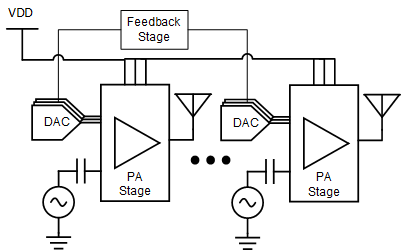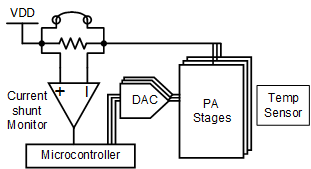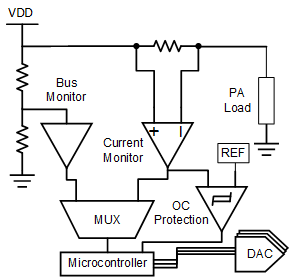SBOA369B december 2019 – july 2023 INA186 , INA190 , INA200 , INA226 , INA228 , INA2290 , INA237 , INA238 , INA290 , INA290-Q1 , INA381 , INA4181 , INA700 , INA780A , INA780B , LMP8480 , LMP8481 , TMCS1100 , TMCS1101 , TMCS1123
This application brief addresses a few of the current shunt monitor (CSM) implementations used with power amplifier stages in wireless infrastructure. With each particular implementation, this note presents the trade-offs as well as recommends a device relevant for the approach.
PA Feedback
Delving past the abstraction of antennas, transmitters, and receivers of an active antenna system (AAS) or remote radio unit (RRU) can yield systems of amplifiers, microprocessors, multiplexors, DACs, and sensors. Of these elements, one of the crucial elements impacting power consumption is the power amplifier stage transmitting out to the users on the network. This power amplifier stage can consist of a Doherty amplifier with a predriver, which can further be reduced down to some LDMOS or GaN transistors configured into class B, AB, and C amplifiers.
Controlling the bias point of the transistors in a PA stage improves the efficiency of the system. An open-loop, fixed-control voltage for the bias neglects the impact of supply variations on the drain side, device aging, and transconductance fluctuations due to temperature changes from heat dissipation and ambient temperature swings. Consequently, feedback facilitating dynamic control to adjust the PA transistors bias points is required, as Figure 1 shows. Depending on the designer’s constraints in board space, cost, precision, number of antennas, and so forth, the best method for the dynamic control can vary. Many approaches include a current shunt monitor (CSM) to serve as part of the feedback chain to adjust the bias and thereby improve efficiency. This note presents three general approaches, with each subsequent implementation having greater control on the bias point and related efficiency of the PA stage.
 Figure 1 PA Stages with
Feedback
Figure 1 PA Stages with
FeedbackFactory Calibration
A single factory calibration with a generated look-table is one way to control a PA stage. During calibration, a PA is subjected to a range of bias voltages or temperatures, while an on or off board CSM (as Figure 2 shows), monitors the load. From the load measurements, a bias value or group of bias values can be programmed into a look-up table that a DAC uses later to control the bias. This process is then extended to each individual PA in the system. Consequently, the number of CSMs depends on how much calibration time in production can be afforded and BOM cost. After production, an off-board or shorted sensor saves power otherwise lost across the shunt. Additionally, if temperature sensors are included in the feedback with the look-up table, regions of PA stages can be adjusted relatively quickly according to the temperature drift, and a result, improves efficiency. As the factory calibration emphasizes cost for a relatively high common-mode, high-side measurement, consider devices such as the INA290 or INA186.
 Figure 2 Current Sense Feedback
Figure 2 Current Sense FeedbackPeriodic Calibration
Although the factory calibration approach improves efficiency over a fixed-bias voltage, the approach neglects supply variation, which can immediately affect the bias and device aging, which gradually affects the bias. To overcome these shortcomings, the system can be designed to periodically power off and recalibrate. From periodic calibration, adjustments are made to the look-up table as the PAs age, the system switches between batteries and solar power, or when the supply begins to droop. With this tighter control is the option of current monitoring and voltage monitoring all integrated into one package, such as in the INA226 or INA228 devices. For more integration, EZShunt™ technology integrates the shunt resistor directly into the leadframe, which generally reduces the design size and procurement effort. Devices such as the INA700 or INA780A are equipped with the EZShunt™ technology with a 2-mΩ or 400-μΩ leadframe resistance respectively. Periodic calibration requires the shunt resistor to be permanently fixed on the board, resulting in constant losses across the shunt. To minimize the losses, a part with low input offset such as the INA190 or INA290 can be used, as the lower offset permits a smaller shunt for improved accuracy. Alternatively, a current sensor such as the TMCS1123 with an isolated hall sensor allows for a high common-mode with minimal losses across the 0.67-mΩ leadframe. Aside from the shunt dissipation, the other concern for periodic calibration is the compromise between added programming and monitor count that is required to provide minimal transmission interruption.
Real-Time Sensing
While the periodic calibration does address known issues with aging and temperature that a designer can anticipate, the calibration does not have immediate dynamic response for unexpected conditions. Continuous current monitoring is sometimes required for critical applications in which tighter control is required. This method allows for quick adjustments to any PA stage for any possible changes in operating conditions. As continuous monitoring requires CSMs for all PA stages, a multichannel device such as the INA2290 or INA4181 can be considered to save board space. For further integration, board savings, and added system protection, devices such as INA381 and INA310A with integrated comparators can be used for overcurrent conditions.
 Figure 3 Bus Voltage, Current, and OC
Feedback
Figure 3 Bus Voltage, Current, and OC
Feedback| Approach | BOM Count | Control | Integrate Bus Monitor | Integrate OC | Shunt Loss |
|---|---|---|---|---|---|
| Factory Calibration | Low | Loose | No | No | Never |
| Periodic Calibration | Medium | Tighter | Yes | No | Always |
| Real-time Sensing | High | Tightest | Yes | Yes | Always |